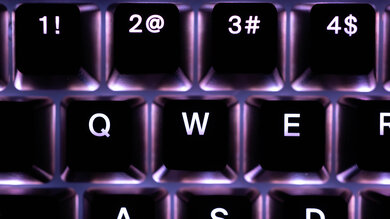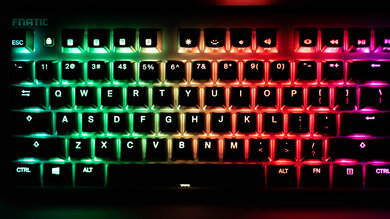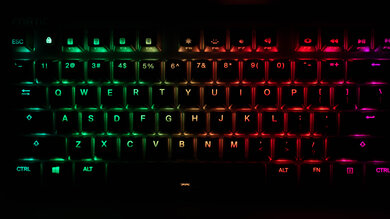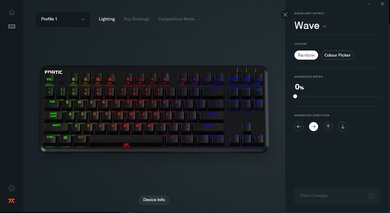The Fnatic miniSTREAK is a TenKeyLess mechanical gaming keyboard. It has individually-lit keys with full RGB backlighting, and you can set macros to any key through the Fnatic OP software. We tested the Cherry MX Silent Red switches, which feel light and responsive, but it’s also available with Kailh Speed Silver switches. While its latency isn’t as low as some other gaming options, it’s still good and should feel very responsive while gaming. Unfortunately, its keycaps are made of ABS plastic, prone to developing shine from finger oils.
Note: There's a discontinued variant with the same name that came with a wrist rest, a different keycap font, and was available with Cherry MX Red, Blue, and Brown switches.
Our Verdict
The Fnatic miniSTREAK is excellent for gaming. This well-built board has customizable RGB backlighting, and all of its keys are macro-programmable. Our unit has Cherry MX Silent Red switches which feel light and responsive, and it's also available with linear Kailh Speed Silver switches. While its latency isn't as low as some other options, it should still feel very responsive. Unfortunately, it doesn't come with a wrist rest, and it only has one incline setting, but you may not need one due to its low profile.
-
Low latency.
-
Customizable RGB backlighting.
-
All keys are macro-programmable.
-
Light and responsive linear switches.
-
No wrist rest.
-
ABS keycaps easily develop shine.
The Fnatic miniSTREAK isn't designed to be used with tablets or mobile devices.
The Fnatic miniSTREAK is good for office use. Our unit has Cherry MX Silent Red switches, which are quiet, light, and responsive, but they don't offer tactile feedback. The board is also available with Kailh Speed Silver switches that are also linear. Unfortunately, it doesn't come with a wrist rest, and it only has one incline setting, which may not be comfortable for some people.
-
Low latency.
-
Light and responsive linear switches.
-
Quiet to type on.
-
No wrist rest.
-
ABS keycaps easily develop shine.
The Fnatic miniSTREAK is good for programming. All of its keys are macro-programmable, and it has customizable RGB backlighting. The linear Cherry MX Silent Red switches on our unit feel light and responsive to type on, and it's also available with Kailh Speed Silver ones. Unfortunately, you can't use it wirelessly, so you can't pair it with any other devices. Also, it lacks a wrist rest and only has one incline setting, which may not be enough for some people.
-
Low latency.
-
Customizable RGB backlighting.
-
All keys are macro-programmable.
-
Light and responsive linear switches.
-
No wrist rest.
-
ABS keycaps easily develop shine.
-
Wired-only design.
The Fnatic miniSTREAK isn't designed to be used with a home theater PC since it's a wired keyboard. It lacks a trackpad, so you need a mouse on the side to navigate the user interface. On the bright side, it has backlighting and media keys.
-
Low latency.
-
Customizable RGB backlighting.
-
No trackpad.
-
ABS keycaps easily develop shine.
-
Wired-only design.
- 8.8 Gaming
- 4.1 Mobile/Tablet
- 7.6 Office
- 7.7 Programming
- 4.9 Entertainment / HTPC
Changelog
- Updated May 05, 2021: Review published.
- Updated May 03, 2021: Early access published.
- Updated Apr 23, 2021: Our testers have started testing this product.
- Updated Apr 21, 2021: The product has arrived in our lab, and our testers will start evaluating it soon.
- Updated Apr 17, 2021: We've purchased the product and are waiting for it to arrive in our lab.
Check Price
Differences Between Sizes And Variants
We tested the Fnatic miniSTREAK Pro with Cherry MX Silent Red switches, but it's also available with Kailh Speed Silver switches. It's an upgraded variant of the discontinued model by the same name, which came with a wrist rest, a different keycap font, and was available in Cherry MX Red, Blue, or Brown switches. You can see the label of our unit here.
Compared To Other Keyboards
The Fnatic miniSTREAK is an excellent TenKeyLess wired gaming keyboard. Like many gaming models, it has RGB backlighting and fantastic customization software to let you remap keys and set macros, but you can also make some of these changes directly from the board. However, it's only available in two types of linear switches, which may be disappointing if you prefer a different feel. It also doesn't come with a wrist rest, and it only has one incline setting, so it isn't as versatile as some other options. Its latency isn't as low as some other options, like the Corsair K70 RGB TKL or the Razer Huntsman Tournament Edition, but it should still feel responsive when gaming.
For other options, see our recommendations for the best keyboards, the best gaming keyboards, and the best mechanical keyboards.
The Razer Huntsman Tournament Edition and the Fnatic miniSTREAK are wired TenKeyLess mechanical gaming keyboards, but the Razer may be a slightly better choice since it has significantly lower latency. Otherwise, both have customizable RGB backlighting, media hotkeys, and all keys are macro-programmable with their separate dedicated software. The Razer is available with Razer Linear Optical switches only, and the Fnatic is available with Cherry MX Silent Red and Kailh Speed Silver switches.
The Corsair K65 RGB Mini and the Fnatic miniSTREAK are both small-form mechanical keyboards, but the Corsair is a compact 60%, and the Fnatic is a TenKeyLess. This difference allows the Fnatic to have a dedicated function row and dedicated arrow keys instead of secondary functions like on the Corsair. If having the lowest latency possible matters a lot to you, the Corsair may be a better choice since its latency is significantly lower than the Fnatic, and it's one of the lowest we've tested. Both boards are available with linear switches only; the Corsair has Cherry MX Speed switches, and the Fnatic is available with either Cherry MX Silent Red switches or Kailh Speed Silver switches.
The Corsair K70 RGB TKL and the Fnatic miniSTREAK are both TenKeyLess, mechanical, gaming keyboards, but the Corsair is slightly larger because of its extra top row for dedicated media keys and volume wheel. The Corsair feels slightly better built with its aluminum top plate and doubleshot PBT keycaps, and it's also better at color mixing. Also, the Corsair has much lower latency, making it a better choice for gaming if switch response time is very important to you. Both boards have incredible customization software, but the Fnatic also lets you set macros directly from the board, while the Corsair needs the software to customize your board.
The Fnatic miniSTREAK and the SteelSeries Apex Pro are mechanical gaming keyboards, but the SteelSeries is a full-size board while the Fnatic is a TenKeyLess. The SteelSeries uses proprietary OmniPoint switches, which let you set the operating force to your preference. Also, it has much lower latency, and it has many extra features like a programmable volume wheel, a USB passthrough, and an OLED screen. The Fnatic is a good gaming choice if you don't need all the extra features the SteelSeries offers. The Fnatic is available with Cherry MX Silent Red and Kailh Speed Silver switches.
The Keychron K6 and the Fnatic miniSTREAK are both mechanical gaming keyboards with RGB backlighting. The Fnatic is an excellent choice if you prefer TKL wired keyboards and want the option to set macros to any key using dedicated software. It's available with two different linear switches: Cherry MX Silent Red and Kailh Speed Silver. On the other hand, the Keychron is a good choice if you like compact wireless keyboards and don't mind finding third-party software to remap the keys. Also, the Keychron has lower latency, and it's available with Gateron linear Red, clicky Blue, or tactile Brown switches.
The Fnatic miniSTREAK and the HyperX Alloy Origins 60 are both wired mechanical gaming keyboards, but the Fnatic is a TenKeyLess, and the HyperX is a compact 60%. The Fnatic's larger size gives it room for a dedicated function row and dedicated arrow keys instead of secondary functions like the HyperX. The HyperX is only available with HyperX Red switches, and the Fnatic is available with Cherry MX Silent Red or Kailh Speed Silver switches. If having the lowest possible latency matters a lot to you, the HyperX is a superb option to consider since its latency is much lower than the Fnatic's, though the Fnatic should still feel responsive.
The Fnatic miniSTREAK and the Razer Huntsman Mini are mechanical gaming keyboards, but the Fnatic is a TenKeyLess, and the Razer is a compact 60%. This difference allows the Fnatic to have a dedicated function row and dedicated arrow keys, which the Razer has as second functions to its alphanumerical keys. The Razer may be a better choice for gaming since it has much lower latency, but the Fnatic's latency should still feel responsive. Also, the Razer is available with clicky Razer Optical switches and with linear Razer Optical switches, so you have two feels to choose between. On the other hand, the Fnatic is only available with the linear feel, but there are two options: Cherry MX Silent Red switches and Kailh Speed Silver switches.
The Fnatic miniSTREAK and the Razer Huntsman Mini Analog are both wired-only mechanical gaming keyboards, but the Razer performs better overall. It has lower latency and better build quality, thanks to its PBT keycaps. Also, the Analog Optical switches allow you to adjust the pre-travel distance on a per-key basis. On the other hand, the Fnatic comes in a TKL size, which might suit you better if you want the dedicated arrow keys.
Test Results
The Fnatic miniSTREAK Pro is slightly slimmer than some other gaming keyboards like the ASUS ROG Strix Scope TKL or Corsair K65 RGB MINI.
The Fnatic miniSTREAK feels very well-built. It’s made of hard plastic with an aluminum top plate which looks nice and exhibits very little flex. There's no rattling, and most of the keys feel very stable, but the larger keys, like the Spacebar, Shift, and Enter, feel a bit wobbly. Unfortunately, the keycaps are made of ABS plastic, which develops shine easily. On the bright side, they still feel good and don’t feel slippery. Also, they’re doubleshot, so they should be more durable.
The Fnatic miniSTREAK Pro is a straight, flat board with floating keycaps, meaning the keys aren’t recessed into the board. It has only one incline setting, and it doesn’t come with a wrist rest, but you may not need one since it has a relatively low profile.
The Fnatic miniSTREAK Pro has full RGB backlighting with individually lit keys. You can adjust the brightness level and cycle through eight lighting effect presets directly from the board, or you can use the Fnatic OP software for even more customization. The backlighting changes to a static color when Game Mode is on. The default is orange, but you can change this to a different color in the software. Unfortunately, the board isn’t good at color mixing, so if you want to set your lighting to white, it looks pink.
The Fnatic miniSTREAK has media hotkeys and dedicated audio mute and mic mute buttons on the top right. Game Mode is activated by pressing the key with the Fnatic logo on it; this locks the Windows key and sets the backlighting to a static color to reduce distractions. You can also choose certain macros and actions to disable when pressing this key. When holding the Fnatic logo button, you can record macros directly from the board. Also, between the Esc and F1 keys, there’s an Fn lock button that locks the function keys so that they default to the secondary functions.
There is also a small magnetic signature plate on the front that you can personalize, although Fnatic doesn’t provide this customization service yet.
The Fnatic miniSTREAK unit we tested has Cherry MX Silent Red, which feel light and responsive. It’s also available with Kailh Speed Silver switches.
The Fnatic miniSTREAK has very good typing quality. Most of the keys are very stable, although the larger keys, like the Shift, Enter, and Spacebar, wobble a bit. The keys feel well-spaced, and there's a slight curve to the keycaps that helps you hit the key in the center. Unfortunately, the keycaps are made of ABS plastic, prone to develop shine from finger oils. Keep in mind that the typing experience will differ if you get the board with Kailh Speed Silver switches.
The Cherry MX Silent Red switches on our Fnatic miniSTREAK unit are very quiet to type on. Note that the noise may be different if you get the Kailh Speed Silver switches.
The Fnatic miniSTREAK has good latency. While it isn't as low as some other gaming options, it should still feel responsive.
The Fnatic miniSTREAK allows you to make some customizations without the Fnatic OP software. You can adjust the backlighting brightness, cycle through eight different lighting presets, and record macros with the Fnatic logo button from the board itself. When recording macros without the software, you can set macros to any key except for Esc, F5-F12, Pause/Break, and the Fn key. However, by using the software, you can set macros to any key, including the exceptions named above. The Fnatic OP software also lets you remap keys and make more customizations to the RGB backlighting.
Some of the keys don't work on macOS, like the Scroll Lock, Break/Pause button, and Fn key. Some keys work but act differently, like F11 minimizes your window, and the Print Screen button registers as F13. The Windows Key registers as a Meta key. Since the software is only available on Windows, there's are limitations to which keys you can set macros, and you can't customize the backlighting as much on macOS or Linux.
Comments
Fnatic miniSTREAK: Main Discussion
Let us know why you want us to review the product here, or encourage others to vote for this product.


































